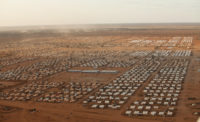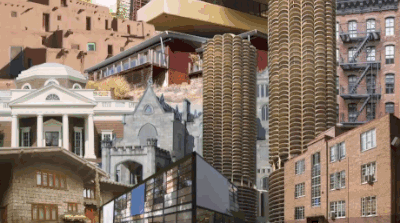How we define “home” can be difficult and deeply personal. Is it where you were born, or where you live now? What if you were forced from your city or village to settle elsewhere? Boris Benjamin Bertram’s documentary The Human Shelter argues that one of the most fundamental ways by which we answer those questions — and grapple with the nature of home, in all its forms — is through shelter, be it a house, apartment, lean-to, or tent.
The 58-minute Danish film had its US premiere at the Los Angeles Architecture & Design Film Festival last week. It was part of a program that included That Far Corner: Frank Lloyd Wright in Los Angeles, as well as a number of films that screened at the New York festival in October, like Frank Gehry: Building Justice, Rams, and Renzo Piano: The Architect of Light.
The Human Shelter begins by introducing viewers to a reindeer farmer and his daughter in Kautokeino, Norway before globetrotting to the Museum of Modern Art in New York, a UNHCR refugee camp in Iraq, NASA’s Mars habitat in Hawaii, a rickety treehouse in Uganda, tiny apartments in Tokyo, the water slums in Lagos, and a lonely dwelling in glacial Iceland. We don’t spend much time in any one place, rarely more than five or six minutes, and we never return once we leave. It can seem episodic and a bit disjointed.
The exception is the segment featuring New York and Iraq, during which MoMA associate curator Sean Anderson sets up the 2016 exhibit Insecurities: Tracing Displacement and Shelter, which included Better Shelter’s Emergency Temporary Shelter. The 188-square-foot, easily-assembled, sturdier-than-a-tent dwelling can accommodate five people and is used by the United Nations in camps like the one we visit in Arabat to house those displaced by international conflicts. Bertram intercuts between New York and Iraq, showing the temporary shelter both as a design object and a dwelling—the jumping off point for his debate about home. One refugee cordones off a section of his shelter to make a closet; another woman covers hers in colorful, patterned fabrics. "We decorate the shelter and feel comfortable here. Before, we decorated our houses this way,” she says. "But,” a relative interjects, “a house is different than a shelter. In the shelter it's cold and sometimes if there is a storm it could tip over."
The New York-Arabat section is the longest of the film and, unquestionably, the strongest. But then it’s off to the next place. It’s a disappointing come down. Using the Emergency Temporary Shelter as the vehicle to tell a larger story about home would have made for a more compelling film than the one we get, no matter how interesting NASA’s prep for a manned Mars mission might be or how unique an experience it is to meet a Ugandan man who built a ramshackle treehouse. Indeed, each episode in The Human Shelter could easily be a starting point for its own feature documentary. The structure Bertram employs can be frustrating, especially in such a short film, since we’re kept at an emotional remove. How can we feel connected to people with whom we spend so little time, and never see again? Yet, as the film progresses, connections across disparate geographies and experiences begin to appear: sports, especially soccer, as a way to build and cultivate community; the value of objects in helping turn a shelter into a home; the emotional-spiritual-memory-physical nexus of lands.
But it’s the subtle background hum of our climate-imperiled planet that ultimately forms a kind of narrative throughline. Between the isolated snow fields of Norway that open the film and the final scenes on a desolate slab of Iceland where a glacier is in full retreat, we visit overconsuming megacities, a man who lives in a tree as a way to call attention to natural resources, people displaced by resource-based conflicts, and a community built above water. In these stories we see our past and present follies and the possible future they portend in a ecologically ravaged world. Bertram only sounds the alarm outright in the final minutes, but the film is unambiguous: How we define home will take on far greater resonance when we’re all refugees of a dying planet.
The next stop for the Architecture & Design Film Festival is the AIA Conference on Architecture in Las Vegas (June 6-8), followed by New Orleans (June 20-24), Athens, Greece (October 10-12), and New York (October 16-20).








